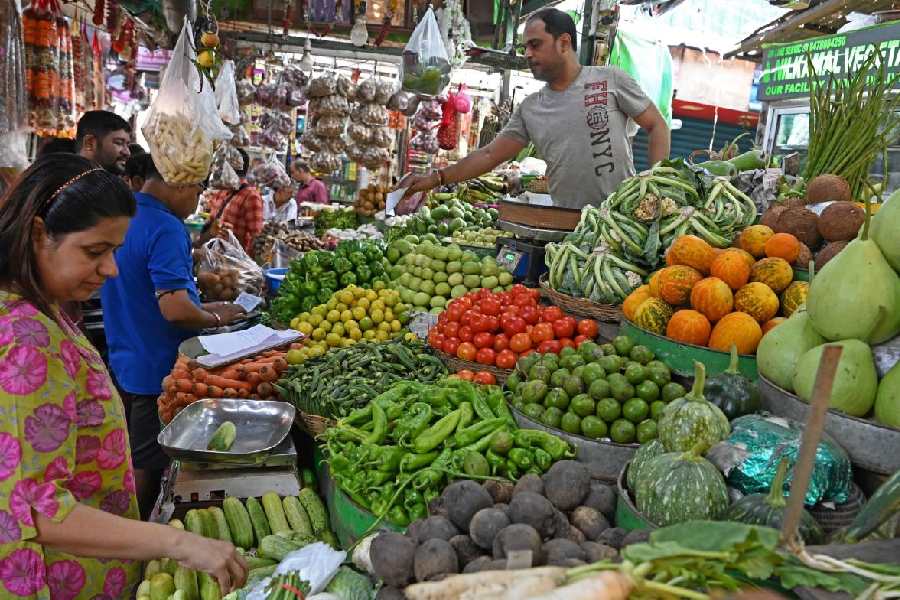A task force set up by the state government visited markets on Monday and Tuesday to find out the reasons for the rise in vegetable prices and suggest ways to bring them down, but the rates were yet to be stable.
The state government wants green chillies to be sold at Rs 100 a kilo. A trip to some of the markets on Tuesday showed they were still being sold between Rs 200 and Rs 250 a kilo.
Tomatoes sold for between Rs 110 and Rs 120 a kilo and brinjals between Rs 120 and Rs 130 a kilo.
Pointed gourds sold for between Rs 50 and 60 a kilo and ridge gourds for Rs 70 a kilo.
Ginger sold for Rs 300 a kilo, lower from the Rs 365 a week back but still way above the normal price. The bitter gourd price was Rs 120 a kilo.
Traders and shoppers said all the prices are much more than the rates that are usual around this time of the year.
Vegetable vendors said if the wholesale rates remain high, they would not be able to bring down the retail prices. The wholesale prices have remained high because of poor supply.
Chillies, for instance.
Bengal produces more chillies than it consumes. The annual yield is 9.5 to 10 lakh tonnes, while the demand is 8 lakh tonnes. Bengal is a major supplier of green chillies to other states.
However, around this time of the year, Bengal depends on supplies from other states because the monsoon harvest falls short of the demand.
“The supply from Uttar Pradesh and Bihar has been erratic this time. Yesterday, more than a dozen trucks, each carrying around 15 tonnes of chillies, reached the wholesale markets in Kolkata and its adjoining areas from Katihar in Bihar,” said Kamal Dey, president of the West Bengal Vendors’ Association.
“On Tuesday afternoon, the wholesale price of chillies varied between Rs 80 and Rs 120 a kilo at Koley Market. We expect this supply will soon bring down the retail prices.”
Several retailers said they were yet to procure chillies at the rate Dey quoted. The wholesale prices varied between Rs 150 and Rs 160 a kilo, they said.
“It is not possible to sell green chillies at Rs 100 a kilo when we are buying them for Rs 150-160 at kilo from wholesalers,” said Jahangir Mondal, a vegetable seller in Gariahat. “Officials may quote a price but they need to check whether it is feasible for retailers to stick to it.”
On Tuesday, the task force members met wholesalers at Koley Market and enquired about the rates of several vegetables.
“The wholesale price of green chillies was Rs 80 a kilo at Koley Market. So, if green chillies are selling at Rs 200 a kilo, it’s a cause of concern,” said Rabindranath Koley, a member of the task force.
“Give me the names of the markets (where the price is around Rs 200 a kilo) and I will send police teams,” he told The Telegraph on Tuesday.
Tomatoes, which sold for Rs 80 a kilo a week back, remained costlier at Rs 120-Rs 130 across markets on Tuesday. Retailers said tomatoes sold for Rs 100-120 a kilo at wholesale markets.
“Around this time, tomatoes reach Bengal from Karnataka, Maharashtra and Himachal Pradesh. There is a trickle from Bangalore. We were hoping to get the bulk from Himachal Pradesh, but the rain there is creating a problem,” said Dilip Ghosh, a wholesaler.
The price of ginger varied between Rs 300 and Rs 310 a kilo across several markets, a climb down from Rs 365 a kilo a week back.
Market observers linked the high price of ginger to the ongoing unrest in Manipur and its fallout in the adjoining North-eastern states. A section of farmers there is holding on to the crop, they said.
Bengal’s ginger is mostly sourced from Manipur and Nagaland around this time.
Traders said truck carrying the crop from the two states have been arrivingirregularly.
The prices of some of Bengal’s own produce, such as pointed gourd, ridge gourd and brinjal, are also much more than what is normal around this time. Supply is thin and that has led to a demand-supply chasm, said a wholesaler.
“Plants wilted in the green belts of North and South 24-Parganas, Hooghly and Murshidabad because of prolonged spells of extreme heat and lack of rain for months,” Dey said.
“As a result, we have a shortage of vegetables this time. The mandis and haats don’t have enough supply from farmers.”
